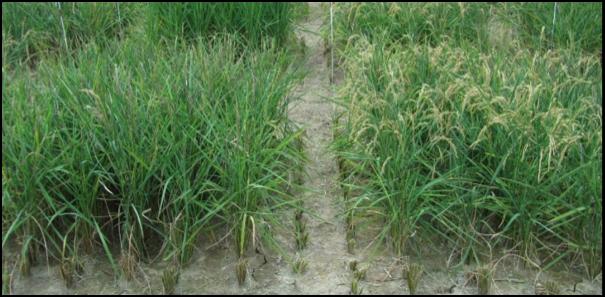New rice fights off drought

Ubi: AtGolS2 improved Curinga grain yield in the target environment. Field performance of unmodified Curinga rice (left) and promising transgenic strain 2580 (right). Photographs were taken during stress at the grain filling stage. Credit: RIKEN and CIAT
As the amount of rice needed to help feed the global population increases, the consequences of drought-related crop reduction are becoming more severe. RIKEN scientists and their collaborators tackled this issue by developing transgenic strains of rice that are more resistant to drought.
Normally, plants adapt to drought-related stress by producing osmoprotectants — molecules like soluble sugars that help prevent water from leaving cells. Galactinol synthase (GolS) is an enzyme needed to produce one these important sugars called galactinol. In previous work, RIKEN scientists showed that Arabidopsis plants express the AtGolS2 gene in response to drought and salinity stress.
“The Arabidopsis GolS2 gene was first identified with basic research at RIKEN,” explains RIKEN scientist Fuminori Takahashi. “Using it, we were able to improve resistance to drought-related stress, and increased the grain yield of rice in dry field conditions. This is one of the best model cases in which basic research knowledge has been successfully applied toward researching a resolution to a food-related problem.”
For this study, they created several lines of transgenic Brazilian and African rice that overexpress this gene, and with their CIAT and JIRCAS collaborators, tested how well the rice grew in different conditions in different years.
The results were very promising. First, they grew the different rice lines in greenhouse conditions and showed that the modified Brazilian and African rice did indeed show higher levels of galactinol than the unmodified control rice. Next, they tested tolerance to drought during the seedling growth period because this period often overlaps with seasonal drought. In order to precisely control this part of the experiment, it was conducted in a rainout shelter that allowed them to artificially create drought-like conditions. After three weeks, the modified strains had grown taller and showed less leaf-rolling, a common response to drought stress.
Drought tolerance was next confirmed at the reproductive stage in three rainout field trials in Colombia. These trials were during different seasons and different locations. Nevertheless, transgenic lines in both species of rice showed higher yield, greater biomass, lower leaf-rolling, and greater fertility than the unmodified rice. Closer examination showed that five of the most promising strains had greater relative water content during drought conditions, and also used more light for photosynthesis, and contained more chlorophyll.
Finally, they tested the transgenic rice over a three-year period in different natural environments. Again, several of the transgenic strains showed higher grain yield under mild and severe natural drought.
When might we see this useful rice on the market? According to Takahashi, the greatest barrier to commercial availability is that they used genetically modified (GM) technology to generate the GolS2 transgenic rice. “Now, we have begun our next collaborative project, in which we will generate useful rice without GM technology. It might take 5-10 years to reach our goal, but we must keep pressing forward because droughts and climate change might get worse in the future.”
###
Reference: Selvaraj M, Ishizaki T, Valencia MO, Ogawa S, Dedicova B, Ogata T, Yoshikawa K, Maruyama K, Kusano M, Saito K, Takahashi F, Shinozaki K, Nakashima K, Ishitani M. Overexpression of an Arabidopsis thaliana galactinol synthase gene improves drought tolerance in transgenic rice and increased grain yield in the field. Plant Biotechnology Journal. doi: 10.1111/pbi.12731.
Media Contact
All latest news from the category: Agricultural and Forestry Science
Newest articles

Recovering phosphorus from sewage sludge ash
Chemical and heat treatment of sewage sludge can recover phosphorus in a process that could help address the problem of diminishing supplies of phosphorus ores. Valuable supplies of phosphorus could…

Efficient, sustainable and cost-effective hybrid energy storage system for modern power grids
EU project HyFlow: Over three years of research, the consortium of the EU project HyFlow has successfully developed a highly efficient, sustainable, and cost-effective hybrid energy storage system (HESS) that…

After 25 years, researchers uncover genetic cause of rare neurological disease
Some families call it a trial of faith. Others just call it a curse. The progressive neurological disease known as spinocerebellar ataxia 4 (SCA4) is a rare condition, but its…





















